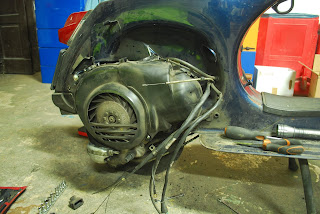The Aprilia is mostly apart, and the engine is now in the shop where I've got it on a table to start work
First order of business is to get the cylinder head off. Not a lot of pictures because it's basically just take off the bolts and hit it a bunch of times with a hammer.
Wow. The head gasket is De-stroy-ed! This could be my compression leak.
Next take off the cylinder. Loosen bolts and hit with hammer. Hit more with hammer. Hit harder with hammer. Ok, and it's loose.
And cylinder base gasket is destroyed too. Well, that's enough for today. Time to take apart the Vespa.
I've got some stuff off already, tossed in a box.
It's just two bolts and a bunch of hitting stuff with a hammer.
Carburetor.
Take off the seat.
Get the wiring things off, all the cables, etc.
Take off the gas tank.
Engine comes out.
That's it for today, minus the steering column






















































